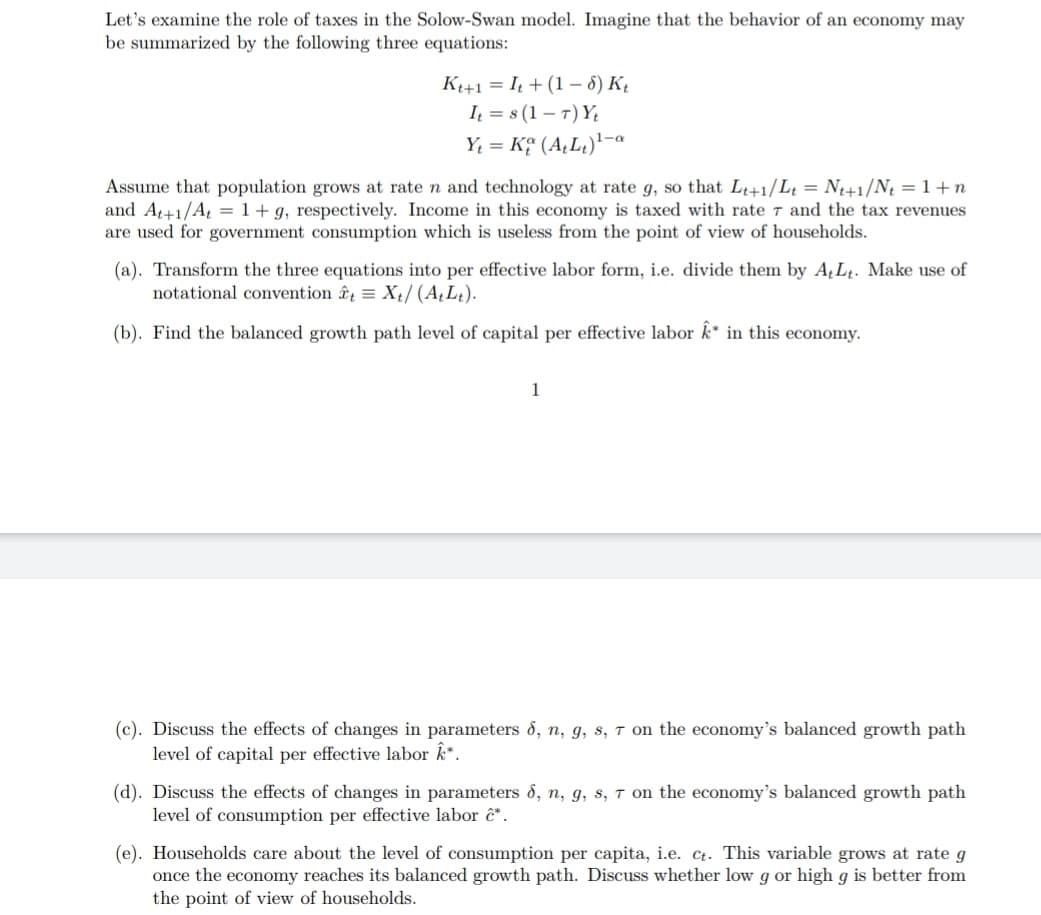Let's examine the role of taxes in the Solow-Swan model. Imagine that the behavior of an economy may be summarized by the following three equations: K+1 = I + (1 – 8) Kį I = s (1 – 7) Y Y; = K¢ (A,L)'-a Assume that population grows at rate n and technology at rate g, so that L+1/L = N4+1/N = 1+n and At+1/A = 1+ g, respectively. Income in this economy is taxed with rate 7 and the tax revenues are used for government consumption which is useless from the point of view of households. (a). Transform the three equations into per effective labor form, i.e. divide them by AL. Make use of notational convention = X/ (A,L).
Let's examine the role of taxes in the Solow-Swan model. Imagine that the behavior of an economy may be summarized by the following three equations: K+1 = I + (1 – 8) Kį I = s (1 – 7) Y Y; = K¢ (A,L)'-a Assume that population grows at rate n and technology at rate g, so that L+1/L = N4+1/N = 1+n and At+1/A = 1+ g, respectively. Income in this economy is taxed with rate 7 and the tax revenues are used for government consumption which is useless from the point of view of households. (a). Transform the three equations into per effective labor form, i.e. divide them by AL. Make use of notational convention = X/ (A,L).
Chapter1: Making Economics Decisions
Section: Chapter Questions
Problem 1QTC
Related questions
Question

Transcribed Image Text:Let's examine the role of taxes in the Solow-Swan model. Imagine that the behavior of an economy may
be summarized by the following three equations:
K++1 = It + (1 – 8) K.
I = s (1 – T) Y
Y; = K¢ (A,Lt)'-a
Assume that population grows at rate n and technology at rate g, so that Lt+1/Lt = N++1/N = 1+ n
and A+1/A = 1+ g, respectively. Income in this economy is taxed with rate T and the tax revenues
are used for government consumption which is useless from the point of view of households.
(a). Transform the three equations into per effective labor form, i.e. divide them by A, L,. Make use of
notational convention = X¢/ (A¿L¿).
(b). Find the balanced growth path level of capital per effective labor k* in this economy.
1
(c). Discuss the effects of changes in parameters 8, n, g, s, T on the economy's balanced growth path
level of capital per effective labor k*.
(d). Discuss the effects of changes in parameters 8, n, g, s, T on the economy's balanced growth path
level of consumption per effective labor ĉ*.
(e). Households care about the level of consumption per capita, i.e. ct. This variable grows at rate g
once the economy reaches its balanced growth path. Discuss whether low g or high g is better from
the point of view of households.
Expert Solution
This question has been solved!
Explore an expertly crafted, step-by-step solution for a thorough understanding of key concepts.
Step by step
Solved in 2 steps

Knowledge Booster
Learn more about
Need a deep-dive on the concept behind this application? Look no further. Learn more about this topic, economics and related others by exploring similar questions and additional content below.Recommended textbooks for you


Principles of Economics (12th Edition)
Economics
ISBN:
9780134078779
Author:
Karl E. Case, Ray C. Fair, Sharon E. Oster
Publisher:
PEARSON

Engineering Economy (17th Edition)
Economics
ISBN:
9780134870069
Author:
William G. Sullivan, Elin M. Wicks, C. Patrick Koelling
Publisher:
PEARSON


Principles of Economics (12th Edition)
Economics
ISBN:
9780134078779
Author:
Karl E. Case, Ray C. Fair, Sharon E. Oster
Publisher:
PEARSON

Engineering Economy (17th Edition)
Economics
ISBN:
9780134870069
Author:
William G. Sullivan, Elin M. Wicks, C. Patrick Koelling
Publisher:
PEARSON

Principles of Economics (MindTap Course List)
Economics
ISBN:
9781305585126
Author:
N. Gregory Mankiw
Publisher:
Cengage Learning

Managerial Economics: A Problem Solving Approach
Economics
ISBN:
9781337106665
Author:
Luke M. Froeb, Brian T. McCann, Michael R. Ward, Mike Shor
Publisher:
Cengage Learning

Managerial Economics & Business Strategy (Mcgraw-…
Economics
ISBN:
9781259290619
Author:
Michael Baye, Jeff Prince
Publisher:
McGraw-Hill Education